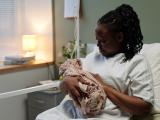Jun 1, 2011
Adjuvanted anthrax vaccine shows promise in clinical trial
A phase 1 trial in healthy adults found that an adjuvanted anthrax vaccine enhanced and accelerated the immune response compared with the vaccine without the booster. The vaccine used in the study was Emergent BioSolutions' BioThrax (anthrax vaccine adsorbed), which is the only anthrax vaccine countermeasure approved for the US stockpile. The booster used in the study is a CpG DNA adjuvant. The 69 study subjects received three doses of the adjuvanted vaccine, the adjuvant alone, or the vaccine by itself. Researchers monitored protective antibody and anthrax toxin-neutralizing antibodies for 56 days and safety for 6 months. The adjuvanted vaccine increased antibody response six- to eightfold and speeded response by 3 weeks. No adverse events were reported, and the adjuvanted vaccine seemed well tolerated. Researchers concluded that the adjuvanted vaccine might shorten the immunization course and shorten the time to protection, which they say could be useful for postexposure prophylaxis.
May 30 Vaccine abstract
Study: 40% of cell phones from hospital patients, visitors harbor pathogens
Patients' and their visitors' cell phones were twice as likely to harbor pathogens as were phones of healthcare workers (HCWs), according to a study published in the American Journal of Infection Control (AJIC). Researchers from Inonu University in Malatya, Turkey, collected swab samples from the keypads, microphones, and ear pieces of 200 cell phones at their medical center. A third of the phones belonged to HCWs, while the rest belonged to patients and their visitors. The researchers found that 39.6% of patients' and visitors' phones tested positive for pathogens, compared with 20.6% of HCWs' phones. In addition, seven patients' phones contained multidrug-resistant (MDR) pathogens such as methicillin-resistant Staphylococcus aureus, while no HCW phones tested positive for MDR pathogens. In a press release from the Association for Professionals in Infection Control and Epidemiology (APIC), which publishes AJIC, the authors state, "Our findings suggest that mobile phones of patients, patients' companions, and visitors represent higher risk for nosocomial pathogen colonization than those of HCWs. Specific infection control measures may be required for this threat."
June AJIC abstract
May 31 APIC press release
FAO, Planck Institute form zoonotic disease partnership
The United Nations Food and Agriculture Organization (FAO) and Germany's Max Planck Institute signed an agreement on May 30 to form a partnership to study zoonotic diseases. One of the main goals is to determine what settings pose the greatest threats for disease transmission among humans, livestock, and wild animals, the FAO said in a press release. The partnership also commits the two groups to helping countries balance their natural resources and biodiversity with the need to expand agricultural production. Ann Tutwiler, the FAO's deputy director-general, said in the statement, "Disease dynamics can no longer be considered in isolation within the livestock sector but must be placed into a broader context of sustainable agriculture, socio-economic development, environment protection and sustainability."
May 30 FAO press release
Team unveils Google dengue trends tool
A team from Children's Hospital Boston and Google have developed an experimental Web-based dengue infection tracking tool designed to help public health officials more quickly detect and monitor outbreaks. They published a description of the new Google dengue trends tool in Public Library of Science (PLoS) Neglected Tropical Diseases. The tool, similar to Google flu trends, uses search trends to pinpoint areas of increased dengue activity. The researchers have included Bolivia, Brazil, India, Indonesia, and Singapore in the new tool, because the countries have large bases of Internet users and surveillance systems that can be used to assess Google dengue trends. In a May 30 blog post, Google said the dengue project got its start when the company was building Google Correlate, a new tool that it launched last week that allows researchers to model real-world behavior using search trends. "Singapore has an impressively timely surveillance system for dengue, but in many countries it can take weeks or months for dengue case data to be collected, analyzed, and made available," the company said, adding that the developers began discussing the need for such a tool during a dengue outbreak at the 2010 Commonwealth Games in New Delhi, India, last October.
Google dengue trends
May 31 Children's Hospital Boston press release
May 31 PLoS Negl Trop Dis report
May 30 Google blog post
Weather tool may herald cholera outbreaks
Rainfall and temperature increases can be used to predict cholera outbreak in areas where the disease is endemic, according to South Korean researchers. After analyzing several years of disease and weather data from Zanzibar, Tanzania, they found that a 1-degree-Celsius rise signaled that cholera cases would likely double within 4 months. They also found that a 200-millimeter increase in monthly rainfall suggested that the number of new cholera cases would rise at a slightly lower but still significant number over the next 2 months. Aside from analyzing the weather and disease patterns, they used a statistical model that has been used to study other infectious disease trends to retrospectively predict the area's cholera burden between 2003 and 2008. Their predicted levels closely matched the surveillance reports. Mohammad Ali, PhD, a senior scientist at the International Vaccine Institute in Seoul, said in a EurekAlert press release that the tool could be useful, because once an outbreak begins, it's too late to blunt the impact with vaccines and other measures. "If we wait for clinical signs of the disease to emerge, that means a large portion of the population is already carrying the cholera bacteria; they just are not yet exhibiting clinical symptoms," he said.
May 31 EurekAlert press release
June Am J Trop Med Hyg abstract


















